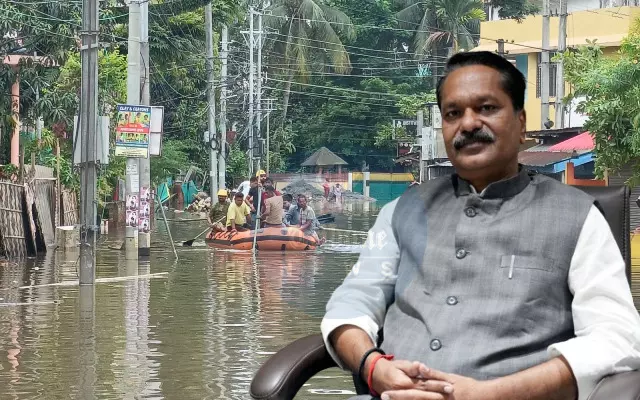
AT Photo
Guwahati, August 6: As an unprecedented urban deluge gripped Guwahati following an hour-long downpour on Monday, the dream of a flood-free city remains elusive despite several measures taken by the state government to address the issue.
From de-siltation work to constructing drains across various parts of the city, Guwahati continues to grapple with artificial floods that frequently bring daily life to a standstill.
In this context, the Assam government, particularly Housing and Urban Affairs Minister Ashok Singhal, could draw major inspiration from neighbouring Tripura, where administrative initiatives have effectively tackled the problem of urban flooding and alleviated citizens' woes.
For six months each year, the capital city of Tripura, Agartala, receives heavy rainfall, with single-day totals often exceeding 200 mm. Until 2018, this intense downpour frequently caused severe flash floods, disrupting the city.
However, in 2018, Agartala Smart City Limited began mapping its 340 km drainage system and has since cleared 50 km of drainage of encroachments.
Additionally, about 25 km of concrete stormwater drains were constructed using Smart City funds, according to an official statement to The Assam Tribune.
Given Agartala’s susceptibility to flooding, installing flood sensors was deemed impractical due to the need for constant activation.
Instead, a Command-and-Control Centre (CCC) was established, and a colour-band system was implemented to manage urban flooding.
Specific flood-prone areas were identified, and colour bands were painted on electricity poles.
“Standard operating procedures (SOPs) were developed for each colour, and CCTVs were installed to monitor these bands. As water levels rose, they were assessed against the bands to guide the deployment of water-suction pumps. For instance, if water levels rose from the green band to the red band, pumps would be activated. Each band had a corresponding SOP to ensure a swift and efficient response,” the smart city official informed.
In Guwahati, the Metropolitan Development Authority under the Government of Assam has enacted the Water Body (Preservation and Conservation) Act 2008 and developed water bodies around the city to enhance retention capacity.
Measures include constructing alternative stormwater drains to divert rainwater away from the city, installing Automatic Weather Stations (AWS), and using auto-priming MF pumps to remove water from vulnerable areas.
Despite these efforts, the government has struggled to achieve its target of a “Mission Flood-Free Assam”, a core agenda since the 2014 election campaign.
In 2022, Union Home Minister Amit Shah reiterated the Centre’s commitment to a flood-free Assam.
“We had promised an Assam free of insurgency, agitations, and floods in our election manifesto. We have delivered on the first two promises. Give us five more years, and we will make the state flood-free,” he declared.
This was the same promise Minister Shah made during the first election campaign, yet the state remains far from realizing this vision.
-(with inputs from our Tripura contributor)
